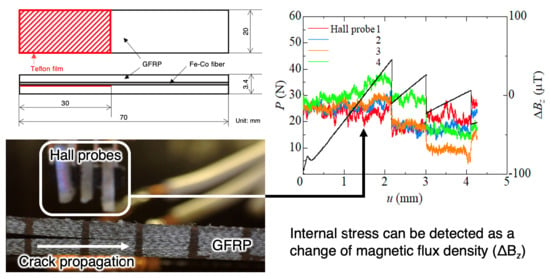Measurement of Magnetic Flux Density Changes in Mode I Interlaminar Fracture in Magnetostrictive Fiber–Embedded Glass Fiber-Reinforced Polymer Composites
Abstract
:1. Introduction
Application of Magnetostrictive Composite Materials in Structural Health Monitoring
2. Materials and Methods
2.1. Material and Specimen Preparation
2.2. Mode I Interlaminar Fracture Tests
2.3. Damage Test and Magnetic Flux Density Measurement
3. Results and Discussion
3.1. Fracture Behavior
3.2. Sensor Characterization
4. Conclusions
Author Contributions
Funding
Data Availability Statement
Acknowledgments
Conflicts of Interest
References
- Correia, J.R.; Almeida, N.M.; Figueira, J.R. Recycling of FRP composites: Reusing fine GFRP waste in concrete mixtures. J. Clean. Prod. 2011, 19, 1745–1753. [Google Scholar] [CrossRef]
- Zheng, L.; Yue, X.; Yue, L.; Wang, Z.; Xie, Y.; Cui, Z. Electrical/thermal stability of GFRP under different intensities γ ray irradiation. Fusion Eng. Des. 2020, 158, 111856. [Google Scholar] [CrossRef]
- Wu, C.; Hwang, H.; Ma, G. Effect of stirrups on the bond behavior of lap spliced GFRP bars in concrete beams. Eng. Struct. 2022, 266, 114552. [Google Scholar] [CrossRef]
- Li, S.; Kang, Z.; Wu, G.; Guo, P.; Gu, S. Acoustic emission-based transition monitoring of mechanical mechanism for bolted shear connection in GFRP-UHPC hybrid beams. Measurement 2022, 198, 111358. [Google Scholar] [CrossRef]
- El-Tayeb, N.S.; Gadelrab, R.M. Friction and wear properties of E-glass fiber reinforced epoxy composites under different sliding contact conditions. Wear 1996, 192, 112–117. [Google Scholar] [CrossRef]
- Tripathi, D.R.; Vachhani, K.H.; Kumari, S.; Dinbandhu, K.; Abhishek, K. Experimental investigation on material removal rate during abrasive water jet machining of GFRP composites. Mater. Today Proc. 2020, 26, 1389–1392. [Google Scholar] [CrossRef]
- Wang, Y.; Chen, G.; Wan, B.; Han, B.; Ran, J. Axial compressive behavior and confinement mechanism of circular FRP-steel tubed concrete stub columns. Compos. Struct. 2021, 256, 113082. [Google Scholar] [CrossRef]
- Takeda, T.; Shindo, Y.; Narita, F. Three-dimensional thermoelastic analysis of cracked plain weave glass/epoxy composites at cryogenic temperatures. Compos. Sci. Technol. 2004, 64, 2353–2362. [Google Scholar] [CrossRef]
- Mitchell, N.; Bauer, P.; Bessette, D.; Devred, A.; Gallix, R.; Jong, C.; Knaster, J.; Libeyre, P.; Lim, B.; Sahu, A.; et al. Status of the ITER magnets. Fusion. Eng. Des. 2009, 84, 113–121. [Google Scholar] [CrossRef]
- Mitchell, N.; Devred, A. The ITER magnet system: Configuration and construction status. Fusion. Eng. Des. 2017, 123, 17–25. [Google Scholar] [CrossRef]
- Shindo, Y.; Miura, M.; Takeda, T.; Saito, N.; Narita, F. Cryogenic delamination growth in woven glass/epoxy composite laminates under mixed-mode I/II fatigue loading. Compos. Sci. Technol. 2011, 71, 647–652. [Google Scholar] [CrossRef]
- Li, N.; Wang, G.D.; Melly, S.K.; Peng, T.; Li, Y.C.; Di Zhao, Q.; de Ji, S. Interlaminar properties of GFRP laminates toughened by CNTs buckypaper interlayer. Compos. Struct. 2019, 208, 13–22. [Google Scholar] [CrossRef]
- Samborski, S. Prediction of delamination front’s advancement direction in the CFRP laminates with mechanical couplings subjected to different fracture toughness tests. Compos. Struct. 2018, 202, 643–650. [Google Scholar] [CrossRef]
- Rzeczkowski, J.; Samborski, S.; de Moura, M. Experimental investigation of delamination in composite continuous fiber-reinforced plastic laminates with elastic couplings. Materials 2020, 13, 5146. [Google Scholar] [CrossRef] [PubMed]
- Rzeczkowski, J.; Paśnik, J.; Samborski, S. Mode III numerical analysis of composite laminates with elastic couplings in split cantilever beam configuration. Compos. Struct. 2021, 265, 113751. [Google Scholar] [CrossRef]
- Rzeczkowski, J.; Samborski, S.; Prokopek, K. Experimental determination of the mode I fracture toughness in FRP laminates with hybrid delamination interfaces. Adv. Sci. Technol. Res. J. 2022, 16, 129–135. [Google Scholar] [CrossRef] [PubMed]
- Guidorzi, R.; Diversi, R.; Vincenzi, L.; Mazzotti, C.; Simioli, V. Structural monitoring of a tower by means of MEMS-based sensing and enhanced autoregressive models. Eur. J. Control 2014, 20, 4–13. [Google Scholar] [CrossRef]
- Pallarés, F.J.; Betti, M.; Bartoli, G.; Pallarés, L. Structural health monitoring (SHM) and nondestructive testing (NDT) of slender masonry structures: A practical review. Constr. Build. Mater. 2021, 297, 123768. [Google Scholar] [CrossRef]
- Manterola, J.; Aguirre, M.; Zurbitu, J.; Renart, J.; Turon, A.; Urresti, I. Using acoustic emissions (AE) to monitor mode I crack growth in bonded joints. Eng. Fract. Mech. 2020, 224, 106778. [Google Scholar] [CrossRef]
- Shang, Z.; Xia, Y.; Chen, L.; Sun, L. Damping ratio identification using attenuation responses extracted by time series semantic segmentation. Mech. Syst. Signal Process 2022, 180, 109287. [Google Scholar] [CrossRef]
- Gorgin, R.; Luo, Y.; Wu, Z. Environmental and operational conditions effects on Lamb wave based structural health monitoring systems: A review. Ultrasonics 2020, 105, 106114. [Google Scholar] [CrossRef] [PubMed]
- Amafabia, D.-a.M.; Montalvão, D.; David-West, O.; Haritos, G. A review of structural health monitoring techniques as applied to composite structures. Struct. Health Monit. 2017, 11, 91–147. [Google Scholar]
- Siwowski, T.; Rajchel, M.; Howiacki, T.; Sieńko, R.; Bednarski, Ł. Distributed fibre optic sensors in FRP composite bridge monitoring: Validation through proof load tests. Eng. Struct. 2021, 246, 113057. [Google Scholar]
- Kousiatza, C.; Tzetzis, D.; Karalekas, D. In-situ characterization of 3D printed continuous fiber reinforced composites: A methodological study using fiber Bragg grating sensors. Compos. Sci. Technol. 2019, 174, 134–141. [Google Scholar] [CrossRef]
- Schueler, R.; Joshi, S.P.; Schulte, K. Damage detection in CFRP by electrical conductivity mapping. Compos. Sci. Technol. 2001, 61, 921–930. [Google Scholar] [CrossRef]
- Wang, Y.; Chen, G.; Wang, Y.; Han, B.; Wan, B.; Hao, Q.; Bai, Y. Tensile strain and damage self-sensing of flax FRP laminates using carbon nanofiber conductive network coupled with acoustic emission. Compos. Struct. 2022, 290, 115549. [Google Scholar] [CrossRef]
- Takeda, T.; Narita, F. Fracture behavior and crack sensing capability of bonded carbon fiber composite joints with carbon nanotube-based polymer adhesive layer under mode I loading. Compos. Sci. Technol. 2017, 146, 26–33. [Google Scholar] [CrossRef]
- Kozioł, M.; Toroń, B.; Szperlich, P.; Jesionek, M. Fabrication of a piezoelectric strain sensor based on SbSI nanowires as a structural element of a FRP laminate. Compos. B Eng. 2019, 157, 58–65. [Google Scholar] [CrossRef]
- Rodríguez-González, J.A.; Rubio-González, C. Influence of graphene nanoplatelet concentration on the electrical, mechanical, and piezoresistive properties of glass fiber/epoxy composites. Poly Compos. 2022, 43, 3276–3289. [Google Scholar] [CrossRef]
- Hassan, H.; Tallman, T.N. Precise damage shaping in self-sensing composites using electrical impedance tomography and genetic algorithms. Struct. Health Monit. 2023, 22, 372–387. [Google Scholar] [CrossRef]
- He, Z.; Li, W.; Salehi, H.; Zhang, H.; Zhou, H.; Jiao, P. Integrated structural health monitoring in bridge engineering. Autom. Constr. 2022, 136, 104168. [Google Scholar] [CrossRef]
- Kwun, H.; Bartels, K.A. Magnetostrictive sensor technology and its applications. Ultrasonics 1998, 36, 171–178. [Google Scholar] [CrossRef]
- Haile, M.A.; Hall, A.J.; Yoo, J.H.; Coatney, M.D.; Myers, O.J. Detection of damage precursors with embedded magnetostrictive particles. J. Intell. Mater. Syst. Struct. 2016, 27, 1567–1576. [Google Scholar] [CrossRef]
- Kubicka, M.; Mahrholz, T.; Kühn, A.; Wierach, P.; Sinapius, M. Magnetostrictive properties of epoxy resins modified with Terfenol-D particles for detection of internal stress in CFRP. Part 1: Materials and processes. J. Mater. Sci. 2012, 47, 5752–5759. [Google Scholar] [CrossRef]
- Norhaniza, R.; Mazlan, S.A.; Ubaidillah, S.A.; Abdul Aziz, S.A.A.; Nazmi, N.; Yunus, N.A. Enhancement of sensitivity of magnetostrictive foam in low magnetic fields for sensor applications. Polymer 2020, 211, 123083. [Google Scholar] [CrossRef]
- Surakarnkha, J.; Zhaoyuan, L.; Gong, P.; Holmes, W.; Desai, P.; Foreman, J.; Morley, N. Designing ferrite impregnated epoxy actuators for impact damage detection in carbon fibre reinforced composites. Compos. Sci. Technol. 2021, 216, 109085. [Google Scholar] [CrossRef]
- Peng, J.; Zhang, S.; Jia, S.; Kang, X.; Yu, H.; Yang, S.; Wang, S.; Yang, Y. A highly sensitive magnetic field sensor based on FBG and magnetostrictive composite with oriented magnetic domains. Measurement 2022, 189, 110667. [Google Scholar] [CrossRef]
- Narita, F.; Katabira, K. Stress-rate dependent output voltage for Fe29Co71 magnetostrictive fiber/polymer composites: Fabrication, experimental observation and theoretical prediction. Mater. Trans. 2017, 58, 302–304. [Google Scholar] [CrossRef]
- Yang, Z.; Wang, Z.; Seino, M.; Kumaoka, D.; Murasawa, G.; Narita, F. Twisting and reverse magnetic field effects on energy conversion of magnetostrictive wire metal matrix composites. Phys. Rapid Res. Lett. 2020, 14, 2000281. [Google Scholar]
- Yang, Z.; Wang, Z.; Nakajima, K.; Neyama, D.; Narita, F. Structural design and performance evaluation of FeCo/epoxy magnetostrictive composites. Compos. Sci. Technol. 2021, 210, 108840. [Google Scholar] [CrossRef]
- Ahmed, O.; Wang, X.; Tran, M.V.; Ismadi, M.Z. Advancements in fiber-reinforced polymer composite materials damage detection methods: Towards achieving energy-efficient SHM systems. Compos. B Eng. 2021, 223, 109136. [Google Scholar]
- Hassani, S.; Mousavi, M.; Gandomi, A.H. Structural health monitoring in composite structures: A comprehensive review. Sensors 2021, 22, 153. [Google Scholar] [CrossRef] [PubMed]
- Wang, M.; Gao, B.; Wu, T.; Hu, B.; Liu, L. Defect depth retrieval method based on nonlinear transformation for pulsed thermographic inspection. Int. J. Therm. Sci. 2020, 149, 106196. [Google Scholar] [CrossRef]
- Wang, Z.; Zhu, J.; Tian, G.Y.; Ciampa, F. Comparative analysis of eddy current pulsed thermography and long pulse thermography for damage detection in metals and composites. Ndt E Int. 2019, 107, 102155. [Google Scholar] [CrossRef]
- Gholizadeh, S. A review of non-destructive testing methods of composite materials. Procedia Struct. Integr. 2016, 1, 50–57. [Google Scholar] [CrossRef]
- Hung, Y.Y. Digital shearography versus TV-holography for non-destructive evaluation. Opt. Lasers Eng. 1997, 26, 421–436. [Google Scholar] [CrossRef]
- Orell, O.; Vuorinen, J.; Jokinen, J.; Kettunen, H.; Hytönen, P.; Turunen, J.; Kanerva, M. Characterization of elastic constants of anisotropic composites in compression using digital image correlation. Compos. Struct. 2018, 185, 176–185. [Google Scholar] [CrossRef]
- Janeliukstis, R.; Mironovs, D. Smart composite structures with embedded sensors for load and damage monitoring—A review. Mech. Compos. Mater. 2021, 57, 131–152. [Google Scholar] [CrossRef]
- Sánchez, D.M.; Gresil, M.; Soutis, C. Distributed internal strain measurement during composite manufacturing using optical fibre sensors. Compos. Sci. Technol. 2015, 120, 49–57. [Google Scholar] [CrossRef]
- Wang, Z.; Kurita, H.; Nagaoka, H.; Narita, F. Potassium sodium niobate lead-free piezoelectric nanocomposite generators based on carbon-fiber-reinforced polymer electrodes for energy-harvesting structures. Compos. Sci. Technol. 2020, 199, 108331. [Google Scholar] [CrossRef]
- Kubicka, M.; Mahrholz, T.; Kühn, A.; Wierach, P.; Sinapius, M. Magnetostrictive properties of epoxy resins modified with Terfenol-D particles for detection of internal stress in CFRP. Part 2: Evaluation of stress detection. J. Mater. Sci. 2013, 48, 6578–6584. [Google Scholar] [CrossRef]
- Adelsberg, N.; Weber, Y.; Yoffe, A.; Shilo, D. Wireless thin layer force sensor based on a magnetostrictive composite material. Smart Mater. Struct. 2017, 26, 065013. [Google Scholar] [CrossRef]
- Na, S.M.; Park, J.J.; Jones, N.J.; Werely, N.; Flatau, A.B. Magnetostrictive whisker sensor application of carbon fiber-Alfenol composites. Smart Mater. Struct. 2018, 27, 105010. [Google Scholar] [CrossRef]
- O’Brien, T.K.; Martin, R.H. Round robin testing for mode I interlaminar fracture toughness of composite materials. J. Compos. Technol. Res. 1993, 15, 269–281. [Google Scholar]
- Kusaka, T.; Hojo, M.; Mai, Y.W.; Kurokawa, T.; Nojima, T.; Ochiai, S. Rate dependence of mode I fracture behaviour in carbon-fibre/epoxy composite laminates. Compos. Sci. Technol. 1998, 58, 591–602. [Google Scholar] [CrossRef]
- Wang, W.X.; Takao, Y.; Yuan, F.G.; Potter, B.D.; Pater, R.H. The interlaminar mode I fracture of IM7/LaRC-RP46 composites at high temperatures. J. Compos. Mater. 1998, 32, 1508–1526. [Google Scholar] [CrossRef]
- Sumikawa, M.; Shindo, Y.; Takeda, T.; Narita, F.; Takano, S.; Sanada, K. Analysis of mode I interlaminar fracture and damage behavior of GFRP woven laminates at cryogenic temperatures. J. Compos. Mater. 2005, 39, 2053–2066. [Google Scholar] [CrossRef]
- K7086-1993; Testing Methods for Interlaminar Fracture Toughness of Carbon Fibre Reinforced Plastics. Japanese Industrial Standard: Tokyo, Japan, 1993. Available online: https://kikakurui.com/k7/K7086-1993-01.html (accessed on 31 October 2023).
- ASTM D5528-13; Standard Test Method for Mode-I Interlaminar Fracture Toughness of Unidirectional Fiber Reinforced Polymer Matrix Composite. ASTM: West Conshohocken, PA, USA, 2022. Available online: https://www.astm.org/d5528-13.html (accessed on 31 October 2023).
- ISO 15024; Fibre-Reinforced Plastic Composites—Determination of Mode I Interlaminar Fracture Toughness, GIC, for Unidirectionally Reinforced Materials. ISO: Geneva, Switzerland, 2001. Available online: https://www.iso.org/standard/25581.html (accessed on 31 October 2023).
- Gunderson, J.D.; Brueck, J.F.; Paris, A.J. Alternative test method for interlaminar fracture toughness of composites. Int. J. Fract. 2007, 143, 273–276. [Google Scholar] [CrossRef]
- Barut, A.; Guven, I.; Madenci, E. Analysis of singular stress fields at junctions of multiple dissimilar materials under mechanical and thermal loading. Int. J. Solids Struct. 2001, 38, 9077–9109. [Google Scholar] [CrossRef]
- Katabira, K.; Komagome, R.; Narita, F. Novel process for monitoring stress in carbon fiber reinforced polymer composites using magnetostrictive wires from cryogenic to high temperatures. Mech. Adv. Mater. Struct. 2022, 1–9, in press. [Google Scholar] [CrossRef]

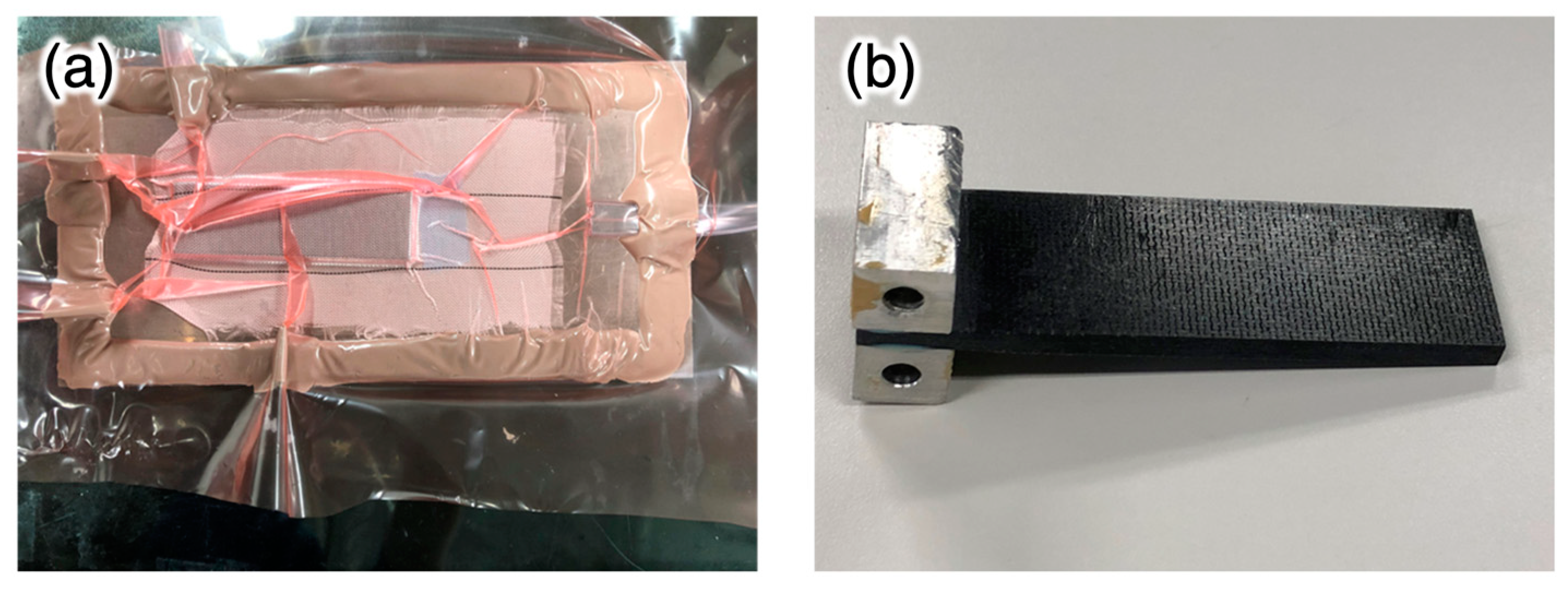

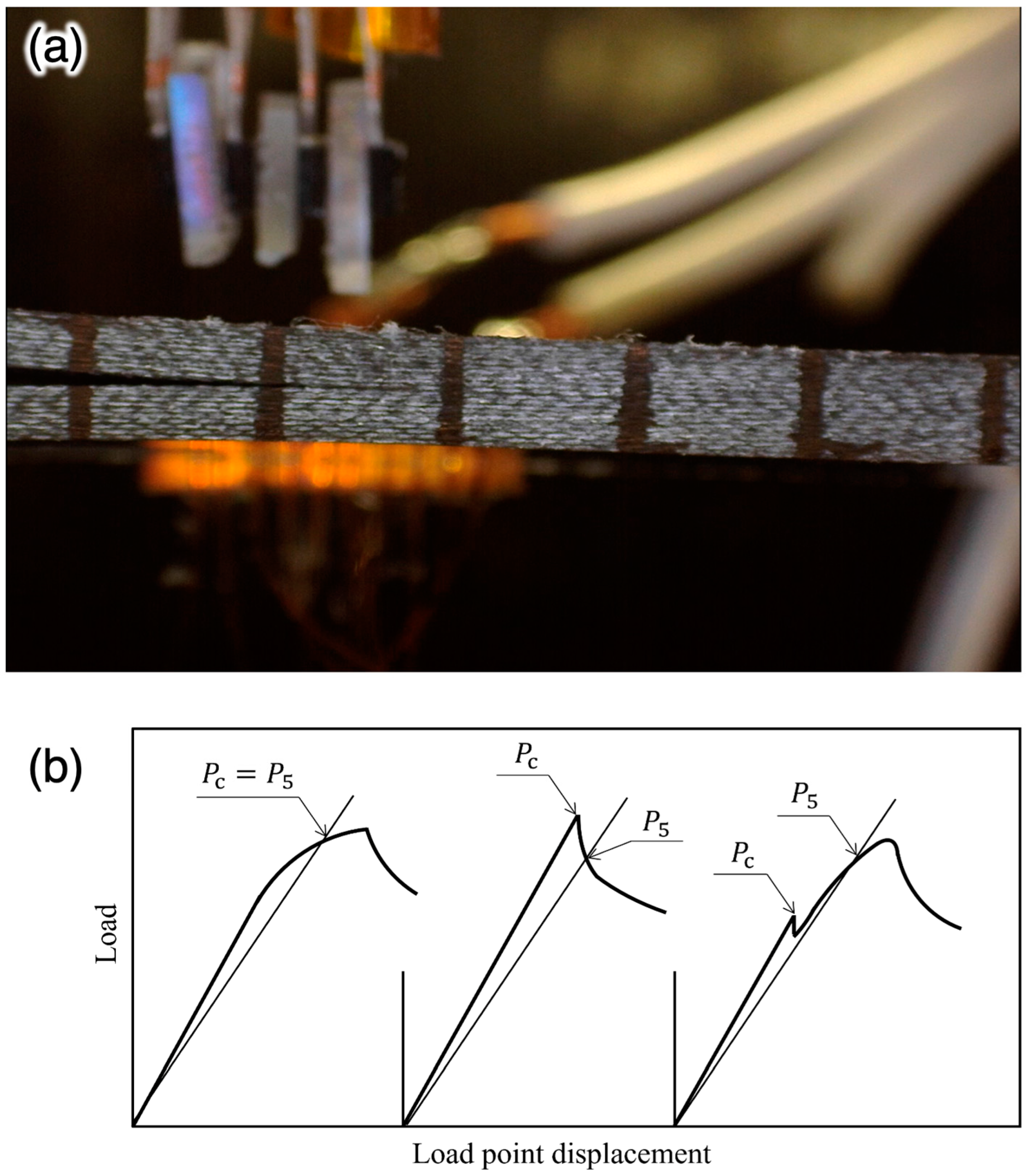


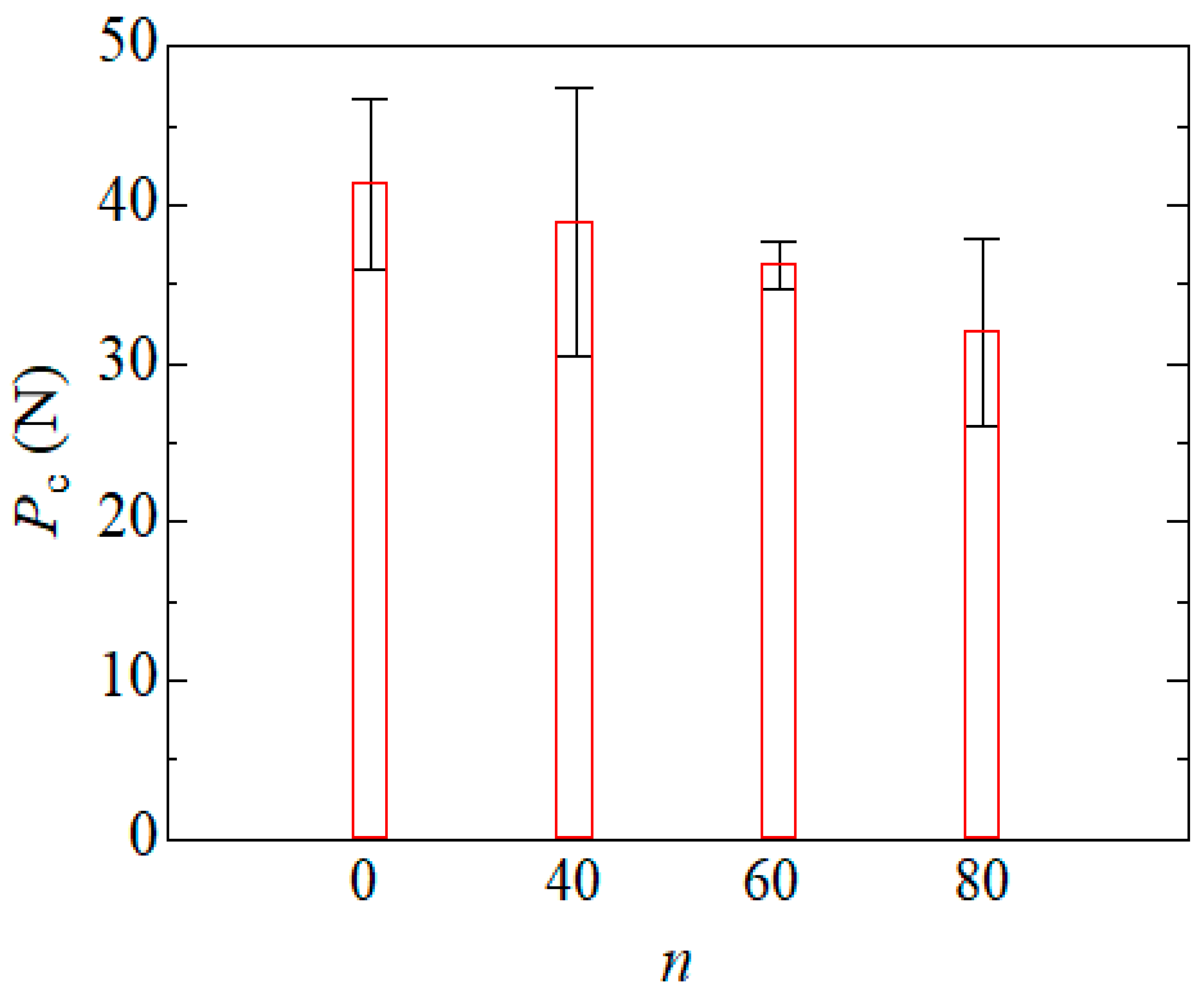

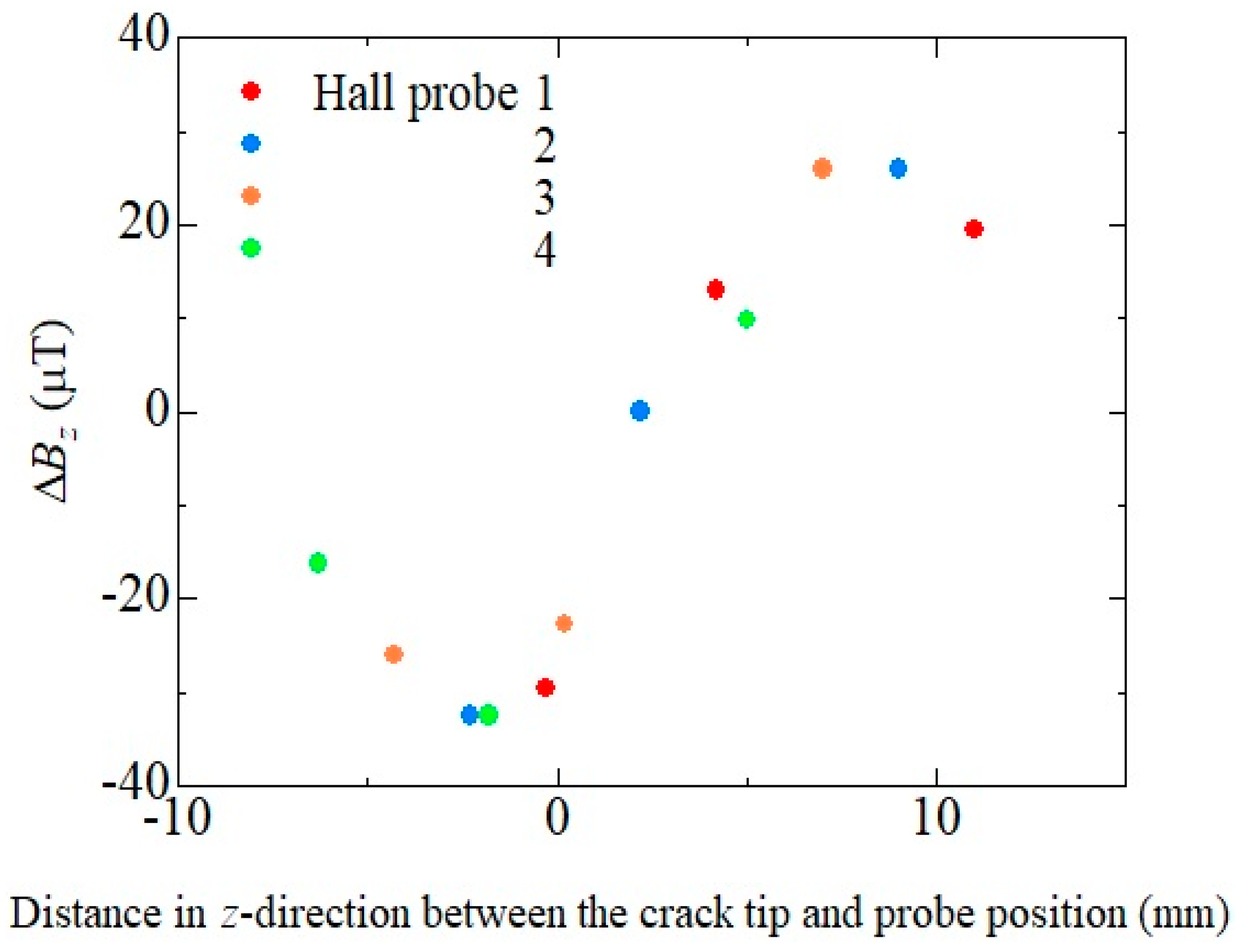
Disclaimer/Publisher’s Note: The statements, opinions and data contained in all publications are solely those of the individual author(s) and contributor(s) and not of MDPI and/or the editor(s). MDPI and/or the editor(s) disclaim responsibility for any injury to people or property resulting from any ideas, methods, instructions or products referred to in the content. |
© 2023 by the authors. Licensee MDPI, Basel, Switzerland. This article is an open access article distributed under the terms and conditions of the Creative Commons Attribution (CC BY) license (https://creativecommons.org/licenses/by/4.0/).
Share and Cite
Miyashita, T.; Katabira, K.; Kurita, H.; Narita, F. Measurement of Magnetic Flux Density Changes in Mode I Interlaminar Fracture in Magnetostrictive Fiber–Embedded Glass Fiber-Reinforced Polymer Composites. J. Compos. Sci. 2024, 8, 8. https://doi.org/10.3390/jcs8010008
Miyashita T, Katabira K, Kurita H, Narita F. Measurement of Magnetic Flux Density Changes in Mode I Interlaminar Fracture in Magnetostrictive Fiber–Embedded Glass Fiber-Reinforced Polymer Composites. Journal of Composites Science. 2024; 8(1):8. https://doi.org/10.3390/jcs8010008
Chicago/Turabian StyleMiyashita, Tomoki, Kenichi Katabira, Hiroki Kurita, and Fumio Narita. 2024. "Measurement of Magnetic Flux Density Changes in Mode I Interlaminar Fracture in Magnetostrictive Fiber–Embedded Glass Fiber-Reinforced Polymer Composites" Journal of Composites Science 8, no. 1: 8. https://doi.org/10.3390/jcs8010008
APA StyleMiyashita, T., Katabira, K., Kurita, H., & Narita, F. (2024). Measurement of Magnetic Flux Density Changes in Mode I Interlaminar Fracture in Magnetostrictive Fiber–Embedded Glass Fiber-Reinforced Polymer Composites. Journal of Composites Science, 8(1), 8. https://doi.org/10.3390/jcs8010008







